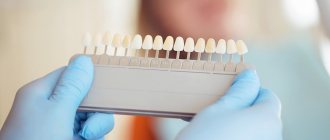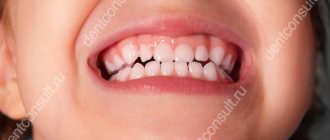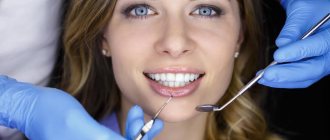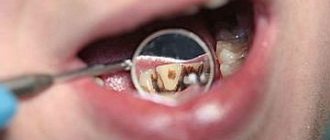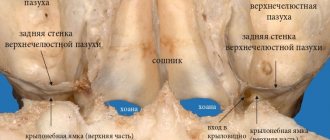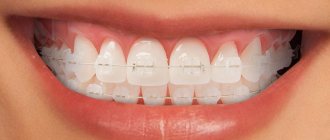What colors of teeth are there?
As a rule, the color of tooth enamel is milky white and translucent, but over the course of life, the tissue can become stained under the influence of various factors. The color of teeth depends not only, or rather not so much, on the enamel, but on the shade and quality of dentin, which shines through the enamel. The younger the person, the denser the layer of enamel on his teeth. In addition, the surface of the tooth is uneven, which means the light is reflected unevenly. The denser the layer of enamel is on the teeth and the more pronounced its surface microrelief, the less it shines through, and, therefore, the tooth looks whiter. Conversely, with age, the tooth surface smoothes out, the enamel layer decreases, and dentin begins to shine through more and more, the natural color of which is much darker than the enamel and can be light brown, yellow or gray. With age, the amount of enamel decreases, dentin also undergoes changes, and red-brown pulp begins to shine through the surface structures of the tooth, therefore, the teeth themselves acquire darker shades. It should be taken into account that dental tissues are usually colored unevenly over their surface: at the cutting edge the color is lighter than at the root. Different teeth also have different shades. For example, canines are often darker than incisors. Today, all age-related changes in the color of teeth are easily corrected by aesthetic dentistry, as well as any other problems associated with the appearance of the dentition.
Myth No. 2: baby teeth can’t be treated
There is a strong opinion that due to the replacement of teeth, you can not pay attention to them at all. Dentists fundamentally disagree with this opinion. “Baby teeth are not only possible, but necessary to be treated. In childhood, inflammatory processes develop much faster than in adults. Secondly, the baby tooth must fully fulfill its function; it holds space for permanent teeth. If you lose it early, it will inevitably lead to bite problems in the future,” says Natalia Kadkalova.
Natural tooth color
Speaking about the natural color of teeth, one cannot fail to mention the characteristics of people with different skin tones. For example, during a recent comparative study of representatives of the Slavic and Iranian groups, scientists identified such a feature. People of the Slavic and Iranian groups most often have a red-brown tint of teeth, less often - reddish-gray. At the same time, among the Slavs, teeth can also be reddish-yellow, but among Iranians, this color was not found in the color of the teeth, as well as gray - in both one and the other group. A comparative analysis of other nationalities shows similar results, indicating that the color of teeth is largely influenced by genetic characteristics and, to a lesser extent, by the environment in which a person lives.
Many people think that people with black skin have beautiful white teeth, but most often this is not the case. African Americans' smiles simply appear brighter. A similar effect, by the way, is observed in tanned people, even those who have only spent a little time in the sun. Therefore, when answering the question of what color natural teeth should be, one should rely on many factors, including those listed above.
By the way, the American Dental Association claims that teeth with a yellowish tint are easiest to whiten. In second place is the brownish tint of the enamel, and the worst response to the whitening procedure is gray teeth, which are often found among Americans.
What determines the natural shade of teeth?
Are your teeth not very white? Are they grayish or yellow in color? Let's see what the possible reasons for this are.
The gray tone is sometimes due to the presence of a large number of old fillings. If you have many teeth that had to be deprived of pulp due to its inflammation, be prepared for the fact that over time such teeth lose their natural shine and become gray. It is difficult to lighten them, but this can be achieved using a new method - endobleaching. In this case, the dentist drills out the old filling, frees the canal, fills it with whitening gel and leaves the gel there for 3-4 days. At the second session, he cleans the canal and puts in a fresh filling.
This is what you have to do with every tooth that is left without a nerve. The operation is long, painstaking, multi-stage and not cheap. But the result is worth a try.
Yellow teeth are common. This is the shade of enamel inherited by a person. Sometimes the enamel is very thin, and the color appears yellowish due to the fact that a layer of dentin, which has a yellow color, shows through the enamel.
Teeth turning yellow with age is normal.
As a person gets older, the pulp sometimes shows through the enamel, which becomes thinner. Then the tooth takes on a dark color, even slightly dark brown. A person may get scared and decide that a disease has begun, but in fact it is just a sign of age.
If your teeth are healthy, don’t let the yellowish tint bother you: dentists believe that such teeth are stronger than those that are white.
How to choose teeth color
The practice of an orthopedic dentist involves the need to choose the shade of dentures. When making prosthetics or restoring one or more teeth in a row, the color is selected in accordance with the patient’s natural teeth. When making complete removable or fixed orthopedic structures, the patient has the opportunity to choose the desired color of the teeth. In this case, you should focus not only on your own desires, but also on the shade of your skin, hair and eye whites. Typically, teeth that are much lighter than the whites of the eyes look unnatural and stand out too much when you smile. In addition, the material from which the crowns or veneers are made should also be taken into account. Thus, plastic and composite materials used to restore teeth look different than metal-ceramics, even with the same color index.
Please note that the color of teeth will be perceived differently in different lighting conditions. That is why, when choosing the shade of veneers or dentures, it is necessary to follow a whole list of conditions, such as natural light, neutral color of the walls in the room and the clothes of the patient and the doctor, the absence of bright lipstick on the lips, and so on.
Myth No. 3: You can only brush your teeth well with a hard brush.
Those who are far from the world of dentistry do not always understand what depends on the hardness of toothbrushes. But it is traditionally believed that hard cleaning removes accumulated plaque better. In reality this is not the case at all. “A hard brush is intended only for cleaning removable dentures. Soft bristles easily penetrate into the interdental spaces and do not injure the gums,” says the dentist.
When it comes to brushes, you only need to strictly adhere to one rule: change it once every 3-4 months, and brush your teeth twice a day.
And the teeth are intact, and he himself is fine. How to avoid getting infected in a dental clinic Read more
Definitions of tooth color
When making dentures, technicians are guided by a special tooth color chart. According to the Vita scale, which is used by almost all dental clinics in the world, natural teeth can have only a few shades: brown, yellow, gray and red. Depending on the intensity category, colors are designated by numbers from 1 to 4. Thus, if a dentist talks about tooth color under the index A1, he means the lightest shade from the reddish-brown range of the table, accordingly, A2 will be slightly darker, A3 - even darker. Index B corresponds to the yellow tone of the teeth and varies in the same way according to the lightness of the shades (B1, B2, and so on). The gray shade is indicated by the Latin letter C (C1, C2, and so on), and reddish-gray teeth - D (namely Latin, not Russian D). The numerical index of the scale indicates the intensity of the color and starts from one, so tooth color 0 actually does not exist.
Advice from Dr. Zubastik
Don't like the color of your teeth? Don't worry, the problem can be solved. If you wish, you can buy a special set of mouth guards and lightening gel and lighten the enamel at home.
But first, consult your doctor: he may advise you to limit yourself to ultrasonic cleaning. In this case, the teeth will become half a tone whiter.
If it’s not enough, use a professional whitening service or install veneers. The main thing is that in pursuit of beauty, do not forget about dental health. Frequent bleaching weakens the enamel. Maybe it’s better to agree with what nature gave - after all, yellowish enamel is really a little stronger than ideal white?
Do you want to lighten your enamel? Watch how it happens:
Tags: Baby teeth, whitening, Teeth color, Vita scale
About the author: Dr. Zubastik
Typically, a toothache begins to subside on the way to the clinic and finally goes away after 10 minutes of sitting in line to see the dentist.
- Related Posts
- Classification of caries: all types
- Waxed and unwaxed dental floss: the difference
- Is it possible to do an MRI with dental implants?
« Previous entry
Myth No. 5: if a filling suddenly falls out, you can insert another one in its place without treatment
It happens that a recently placed filling suddenly falls out at the most inopportune moment. And this is not always caused by toffees, chewing gum or other sticky products. Naturally, many people think that since the therapy was recent, there is no need to treat again. “The filling doesn’t just fall out. There's always a reason for this. And, as a rule, this is an inflammatory process (secondary caries). To avoid this in the future, it is necessary to eliminate it and only place a new filling in a “clean” cavity,” says Natalia Kadkalova.
Be careful, raid! How and why to clean your tongue? More details
In what cases is the Vita scale used - recovery methods
The Vita color scale allows you to evaluate the actual shade of enamel and identify possible deviations from the norm. This is a kind of hint that helps to assess the current clinical picture. This tool is used before whitening, restoration, prosthetics, installation of veneers and lumineers. Here are the main options for restoring the natural whiteness and beauty of a smile, for which the Vita palette is usually used:
- professional hygiene – removal of plaque and tartar in the dentist’s office, allows you to eliminate pathological lesions at their very beginning, as well as restore the natural color of the enamel,
- home whitening is a set of techniques that involve the use of special gels, ointments, pastes, trays and pads impregnated with a whitening composition. Such techniques make it possible to lighten the enamel by several tones, but the effect cannot be called long-lasting,
- in-office whitening - photo whitening, laser, sandblasting, ultrasonic, intracanal, etc. Each technique has its own pros and cons, indications and contraindications. In any case, a professionally performed procedure allows you to achieve a pronounced and long-term effect,
- orthopedic restoration, including microprosthetics - this category includes artificial crowns, dentures, veneers and lumineers. Here we are talking not just about lightening the enamel, but also about correcting other defects, for example, chips and cracks, partially destroyed elements.
The scale allows you to evaluate and select the true shade of enamel
“When I was getting veneers, I had a lot of trouble with these colors. She herself is blonde and has fair skin, so there were specific problems with the choice of shade. At first one dentist suggested A1, but I thought it was a bit too much. As a result, with another doctor we settled on A2 - it looks more natural. In artificial light there is no feeling that your smile is porcelain. I’m very pleased that I went to another specialist and chose this option.”
NinaKom., Moscow, from correspondence on the woman.ru forum
The choice of a specific technique directly depends on the clinical picture, the desired effect, the cause of dental problems, as well as the financial capabilities of the patient. If it's just a matter of yellowed enamel, don't rush to self-medicate. Even before starting at-home whitening methods, you should consult with your dentist.
Myth #4: After eating you should brush your teeth with a toothpick.
Toothpicks are offered in different types: with and without flavors, figured, regular. At the same time, while using toothpicks, many people forget about other options for oral hygiene. And they are sometimes of better quality than wooden sticks with sharp tips.
“As I like to say, a toothpick is a great endodontic tool. I do not recommend using it under any circumstances. It’s better to use dental floss,” the dentist notes. It is also worth remembering that today there are irrigators to provide better dental hygiene.
